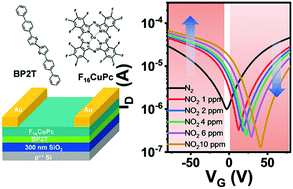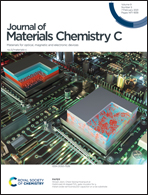High performance gas sensors with dual response based on organic ambipolar transistors†
Abstract
Organic semiconductor gas sensors are of great interest, owing to their promising advantages in room temperature operation and high selectivity. In the past decades, most relevant research focused on unipolar OFET-based sensors. Ambipolar transistors, with two types of charge carriers involved in the operation, provide further possibility for highly selective sensing. Herein, gas sensors based on an ambipolar OFET fabricated with a 2,5-bis(4-biphenylyl)bithiophene (BP2T) and copper hexadeca-fluorophthalocyanine (F16CuPc) bilayer are reported along with their response to several redox gases, including NO2, NH3, H2S and SO2. The ambipolar devices demonstrate clear dual response based on the current (or conductivity) signal, along with the great advantages of being multi-parameter, high output signal and better stability compared to unipolar transistors for sensing gases from NO2 to NH3. In addition, an obviously higher absolute signal change (ΔI, ΔV) could be observed with the ambipolar transistors, even for gases that are hard to detect using the BP2T or F16CuPc unipolar transistors such as SO2 or H2S. These advantages enable the ambipolar transistors to much more easily distinguish target gases with additional parameters, high sensitivity and good stability.



 Please wait while we load your content...
Please wait while we load your content...